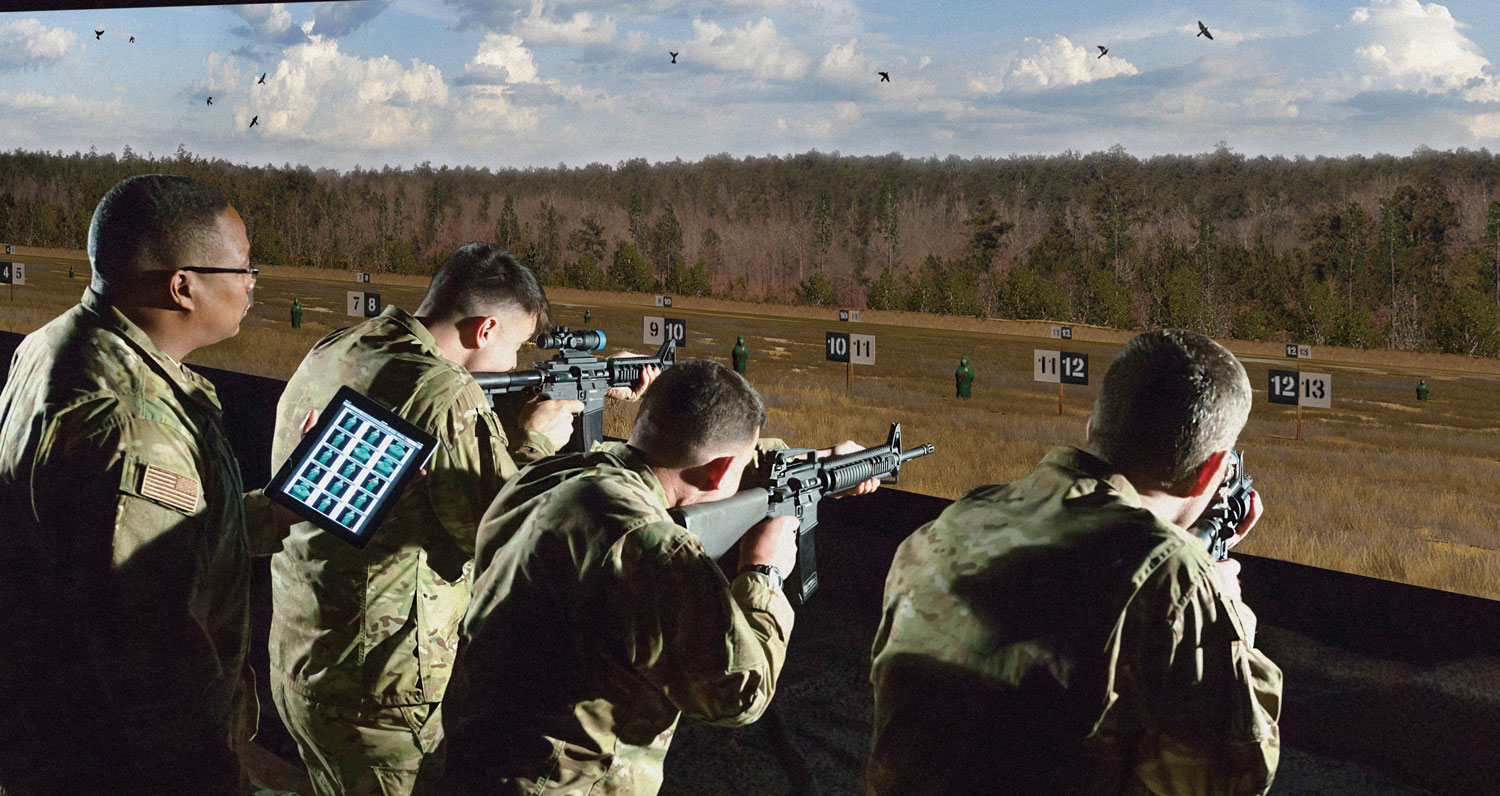Category: Military23.06.2023

Military training has come a long way in recent years. Technology has enabled new methods of simulation training that can prepare military personnel with a more realistic and effective way to be more proficient at their core competencies than in years past. Among these technologies, projection-based, Augmented Reality (AR), and Virtual Reality (VR) simulators are leading the way.
But how do you decide which technology is the best fit for your training needs? Let’s take a closer look at these three types of military training simulators to help you make an informed decision.
The FATS 100MIL is a projection-based simulator that delivers advanced weapon handling and shot placement analytics, enabling instructors to provide tailored coaching to trainees. Marksmanship is arguably the primary core skill for any soldier. Accurate shooting fundamentals are an integral part of both an individual, team, and collective capability of any modern Army. The 100 MIL offers this capability in all modes.
As a projection-based simulator, the FATS 100MIL gives trainees visually realistic and highly detailed terrains and targets on a screen, along with a wide range of environmental effects, weather conditions, and visual effects, such as wind-blown environments that can simulate the Ballistic effects for wind values as well as provide accurate moving target lead training.
The system’s realistic ballistic effects add another layer of immersion, making the training experience as close to real combat scenarios as possible. With the capability to assign up to 60 wireless BlueFire direct and indirect weapons for up to 15 trainees concurrently, this platform supports both individual and group training exercises.
The FATS 100MIL system provides an impressive array of functionality for both instructor and trainee, delivering solid weapon handling and shot placement analytics, coaching tools that automatically highlight trainee results for reinforcement or correction, and enhanced graphic capabilities for an all-encompassing immersive training platform.
The FATS 100MIL projection-based simulator is an excellent choice if you’re looking for a training system that allows trainees to familiarize themselves with the actual weight, heft, feel, and ergonomics of the weapons they will be using on the field, while offering robust marksmanship analytics, immersive graphics, and the capability to handle large group training exercises.
InVeris SRCE (See, Rehearse, and Collectively Experience) is the only untethered AR training solution available on the market today. This system blends real physical environments, obstacles, and live team members with Computer Generated Imagery (CGI) virtual characters, avatars, and assets so trainees can see their own hands, feet, weapons, teammates and surroundings as well as CGI elements using an AR headset.
SRCE can simultaneously support up to four trainees using BlueFire weapons for unparalleled mission rehearsals at the actual location or in a recreated “twin” of the final mission destination.
One of the most significant advantages of SRCE is its environment scanning and replication technology. This feature allows training sessions to be held in virtually any indoor location worldwide, enabling geographically separated instructors and trainees to interact as if they were together. SRCE also delivers training performance data immediately, allowing for real-time After-Action Reviews (AAR). This instant feedback makes it possible for trainees to see their progress and improvements in real time.
If your training requires flexibility in terms of location, the ability to blend real and virtual elements, and real-time performance feedback, then SRCE is the system for you.
SURVIVR is a VR training system for de-escalation of force with robust features, environments, and scenarios for military police and security forces within the US Armed Forces. It creates lifelike military training environments, such as base commissaries, base housing, gates, brigs, visitors centers, and more, to provide trainees with highly realistic, high-stakes scenarios. These military environments can even be customized to look exactly like a real installation upon request.
One of the standout features of SURVIVR is its ability to render a virtual avatar for each trainee, allowing them to interact realistically in multi-user experiences. The software supports a variety of military uniforms and allows instructors to set the ranks of trainees and other avatars.
Using SURVIVR, instructors can quickly create and save a variety of scenarios, including active shooter scenarios, gate runner scenarios, intoxicated persons, emotionally disturbed persons, suicidal individuals, and visitor disturbances. It allows the Trainer the ability to escalate, de-escalate then re-escalate the situation on command if desired.
SURVIVR also offers enhanced capabilities like dual-screen views and 3D After Action Review (AAR). Instructors can also make use of a wide array of data, from suspect distances and head tracking to lethal weapon usage.
If your training program places a high emphasis on de-escalation scenarios and requires a highly immersive, realistic VR environment, SURVIVR is the ideal choice.
Each of these military training simulators—FATS 100MIL, SRCE, and SURVIVR—brings unique advantages to the table. Choosing the right one depends on your specific training needs and objectives. InVeris understands the key outcome for any close quarter shooting continuum is the trainees’ ability to engage and neutralize static and moving targets from as close as 5m out to 400m, from the prone, kneeling, standing supported firing positions whilst employing rapid realignment techniques from cover. The end state is to ensure that soldiers become experts in close, lethal combat by improving their basic skills in a high tech, all-weather, low cost venue without the need for live ammunition or additional safety staff or templates. Whether it’s projection-based simulation, AR, or VR, the key is to identify which features align best with your training objectives.
Remember, the best training tool is the one that helps your trainees to learn effectively and efficiently, preparing them for the diverse challenges they will face in their roles.